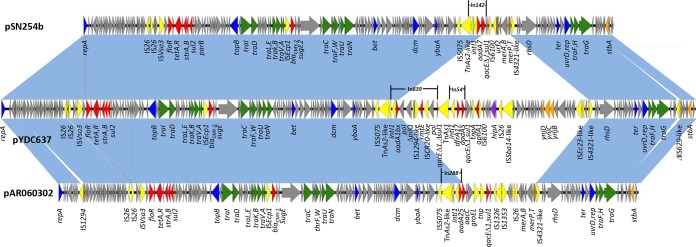LETTER
RmtE is a rare 16S-RMTase which was first reported in an aminoglycoside-resistant Escherichia coli strain of calf origin (1). Subsequently, we reported the first human case of infection caused by RmtE-producing E. coli (2). The rmtE gene is carried on a self-conjugative plasmid (pYDC637) in the latter strain. The present work aimed to elucidate the genetic context of rmtE. The sequencing approach has been described previously (3). In brief, the plasmid was extracted from an E. coli TOP10 transformant carrying pYDC637 and sequenced on a PacBio RS II sequencing instrument (Pacific Biosciences, Menlo Park, CA). Assembly was also conducted using the HGAP pipeline (Pacific Biosciences) as previously described (3).
pYDC637 is an IncA/C plasmid 199,469 bp in size with a G+C content of 52.1%. It harbors 241 predicted open reading frames (ORFs) and is composed of a 144-kb core region and one distinct acquired region spanning 55 kb (Fig. 1). The core region includes genes responsible for plasmid replication, horizontal transfer, and stability and maintenance functions and defines the plasmid backbone (4). This arrangement is shared with blaCMY-2-carrying IncA/C plasmids that have been identified in Aeromonas salmonicida and E. coli isolates from different countries, such as pSN254b, pAR060302, and pUMNK88 (GenBank accession no. KJ909290, FJ621588, and HQ023862, respectively). The core region in pYDC637 encodes IncA/C replication initiation protein gene repA and genes involved in the conjugative transfer of plasmids (traIDLEKBVACWUN and traFHG). In addition to the tra genes, various antimicrobial resistance genes are identified in this region, including floR (florfenicol resistance gene), tet(A) (tetracycline resistance), tet(R), strA and strB (strA,B) (streptomycin resistance), sul2 (sulfonamide resistance), and blaCMY-2 (cephalosporin resistance), which are highly conserved among blaCMY-2-carrying IncA/C plasmids (4).
FIG 1.

Comparative analysis of IncA/C plasmid pYDC637 (GenBank accession no. KP056256) with two other blaCMY-2-carrying IncA/C plasmids, pSN254b (KJ909290) and pAR060302 (FJ621588). Light-blue shading indicates shared backbone regions with a high degree of homology. ORFs are indicated by arrows and are colored according to their putative functions. Dark-blue arrows indicate replication-associated genes. Green arrows indicate genes that are associated with plasmid conjugal transfers, and brown arrows indicate genes that are involved in plasmid stability. Red arrows indicate antimicrobial resistance genes. Yellow arrows indicate accessory genes of mobile elements. Dark-purple arrows indicate other backbone genes.
Downstream of the core region, pYDC637 has a distinct acquired region that harbors a variety of antimicrobial resistance genes in two class 1 integrons. The first integron, bounded by two transposase genes found in A. salmonicida, carries aadA1bx (encoding streptomycin resistance) as the only gene cassette. A unit bracketed by two identical copies of a putative pol gene is located between aadA1bx and qacEΔ1-sul1. Within this unit, rmtE is bound by an ISCR20-like element and an IS1294-like insertion sequence. These IS91-like transposable elements are often identified in association with antimicrobial resistance genes, including 16S-RMTase genes. For example, rmtF and rmtD1-rmtD2 are flanked by ISCR5-like and ISCR14 elements, respectively (5–7). This unique arrangement suggests that they likely played a role in the initial mobilization of rmtE, whose origin remains unknown. It is also possible that the pol duplication was created in this process given the putative transposition mechanism. The second integron contains dfrA17 (trimethoprim resistance) and aadA5 (streptomycin resistance) as gene cassettes. Thus, the structure of pYDC637 is characterized by incorporation of rmtE in a class 1 integron into a blaCMY-2-carrying IncA/C plasmid. RmtE remains a rare 16S-RMTase at this point, having been identified in only one animal E. coli strain and one human E. coli strain. However, coproduction of RmtE and CMY-2 along with other various resistance elements from a broad-host-range, self-conjugative plasmid suggests its potential for future spread.
Nucleotide sequence accession number.
The plasmid sequence reported in this work appears under accession number KP056256.
ACKNOWLEDGMENTS
We thank Thomas Jové for his assistance in the analysis and curation of the integrons.
The effort of Y.D. was supported in part by research grants from the National Institutes of Health (R21AI107302 and R01AI104895).
Y.D. has served on an advisory board for Shionogi, consulted for Melinta Therapeutics, and received a research grant from Merck. C.-S.L. and J.-J.L. have no conflicts of interest to declare.
REFERENCES
- 1.Davis MA, Baker KN, Orfe LH, Shah DH, Besser TE, Call DR. 2010. Discovery of a gene conferring multiple-aminoglycoside resistance in Escherichia coli. Antimicrob Agents Chemother 54:2666–2669. doi: 10.1128/AAC.01743-09. [DOI] [PMC free article] [PubMed] [Google Scholar]
- 2.Lee CS, Hu F, Rivera JI, Doi Y. 2014. Escherichia coli sequence type 354 coproducing CMY-2 cephalosporinase and RmtE 16S rRNA methyltransferase. Antimicrob Agents Chemother 58:4246–4247. doi: 10.1128/AAC.02627-14. [DOI] [PMC free article] [PubMed] [Google Scholar]
- 3.Li JJ, Lee CS, Sheng JF, Doi Y. 2014. Complete sequence of a conjugative IncN plasmid harboring blaKPC-2, blaSHV-12, and qnrS1 from an Escherichia coli sequence type 648 strain. Antimicrob Agents Chemother 58:6974–6977. doi: 10.1128/AAC.03632-14. [DOI] [PMC free article] [PubMed] [Google Scholar]
- 4.Call DR, Singer RS, Meng D, Broschat SL, Orfe LH, Anderson JM, Herndon DR, Kappmeyer LS, Daniels JB, Besser TE. 2010. blaCMY-2-positive IncA/C plasmids from Escherichia coli and Salmonella enterica are a distinct component of a larger lineage of plasmids. Antimicrob Agents Chemother 54:590–596. doi: 10.1128/AAC.00055-09. [DOI] [PMC free article] [PubMed] [Google Scholar]
- 5.Toleman MA, Bennett PM, Walsh TR. 2006. ISCR elements: novel gene-capturing systems of the 21st century? Microbiol Mol Biol Rev 70:296–316. doi: 10.1128/MMBR.00048-05. [DOI] [PMC free article] [PubMed] [Google Scholar]
- 6.Galimand M, Courvalin P, Lambert T. 2012. RmtF, a new member of the aminoglycoside resistance 16S rRNA N7 G1405 methyltransferase family. Antimicrob Agents Chemother 56:3960–3962. doi: 10.1128/AAC.00660-12. [DOI] [PMC free article] [PubMed] [Google Scholar]
- 7.Tijet N, Andres P, Chung C, Lucero C, WHONET-Argentina Group, Low DE, Galas M, Corso A, Petroni A, Melano RG. 2011. rmtD2, a new allele of a 16S rRNA methylase gene, has been present in Enterobacteriaceae isolates from Argentina for more than a decade. Antimicrob Agents Chemother 55:904–909. doi: 10.1128/AAC.00962-10. [DOI] [PMC free article] [PubMed] [Google Scholar]


